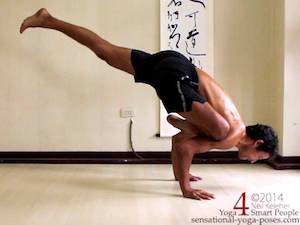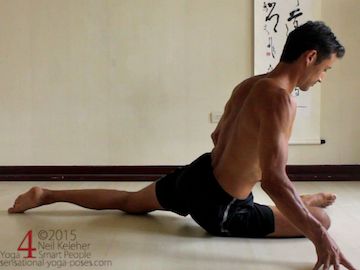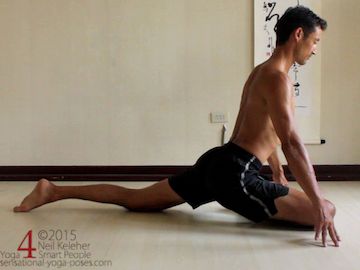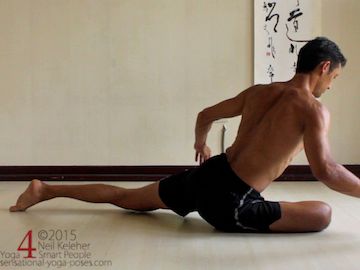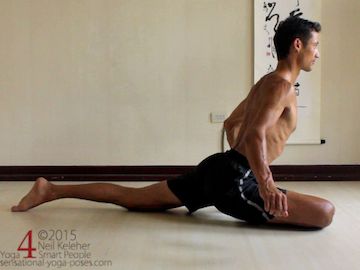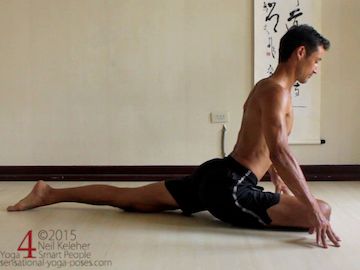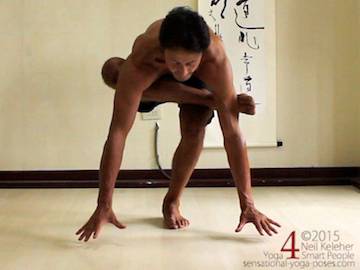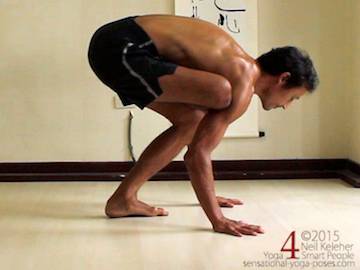Galavasana (Flying Pigeon) Arm Balance
Using Hip Tension to Create Lift and Stability
An interesting pose to practice stabilization is the arm balance called Galavasana. It's also known as flying pigeon because of it's similarity to pigeon pose. And actually pigeon pose is a good way to learn some of the necessary stabilizing actions in this arm balancing yoga pose.
Pigeon Pose (as a Prep for Galavasana)
When working with beginners or people new to pigeon pose one of the actions I often teach is how to lift and lower the hip of the front leg.
The reason I use this as an introduction to galavasana arm balance is that a similiar action is used to lift the hips in galavasana.
Press down with the front knee to lift the hip in pigeon pose.
Initially you can do it using the arms to support the weight of the upper body (shown above).
But the idea is to learn to use the leg itself to help lift the hip and lower it (shown below).
Pressing down with the knee activates the muscles along the outer thigh and outer hip. That downwards force at the knee results in the hip on the same side lifting.
- This action can be made harder by learning towards the front leg side.
- It can be made easier by learning away from the front leg side. With just the right amount of sideways learn the hip is easy to lift.
While holding pigeon pose, the job can be that of maintaining enough pressure to keep the pelvis level from left to right while at the same time reaching the back leg further back so that the pelvis gradually sinks (second picture below).
In the second picture my pelvis is lower (I've reached my back leg further back).
Getting In to Galavasana
For the galavasana arm balance the shin rests against the back of both arms. Stand on one leg and put the other leg in pigeon position with the ankle on the knee of the standing leg. Bend forwards so that the pigeon-leg shin rests against the back of both upper arms.
Positioning the Shin for Galavasana
It can be very uncomfortable so you have to find a way of positioning the shin so that the muscles and skin at the back of either arm (particularly the arm closest to the knee) are comfortably out of the way.
With weight on the standing leg and the hands on the floor, lean forwards and actively press the shin into the backs of both arms.
Using Leg Tension
Use the tension in the leg to support your pelvis so that your bottom leg can relax a little. Apply more tension to press your pelvis higher. If your weight is far enough forwards you should then be able to relax the supporting leg and lift it. Keep the knee of the lifted leg bent and pulled forwards initially. Find your balance in this position and then reach the leg back behind you.
Staying Balanced as You Reach Your Leg Back
To stay balanced while reaching your leg back in Galavasana, you may find it easier to focus on reaching your leg back. You may find that your torso leans forward automatically. Failing that focus on keeping even pressure between the fronts of your hands and the heels of your hands as you reach your torso forwards. Then reach your leg back to prevent yourself from falling on your face.
Lifting the Leg Higher In Galavasana?
This is an example of using tension to create stability. The tension in the front leg makes it easier to lift the pelvis. In this case the tension doesn't lead directly to improving balance. Instead it provides lift.
If you find that you can't straighten your leg back completely, then try lifting both your pelvis and your back leg higher. The higher you lift your leg the less far forward you need to reach your torso forwards in order to stay balanced. To lift the leg higher first focus on lifting your pelvis higher. And to lift your pelvis higher focus on pressing your shin down with greater pressure against your arms.
Published: 2016 01 30
Updated: 2020 10 28
Galavasana Yoga Arm Balance
Return to TOP of Page
